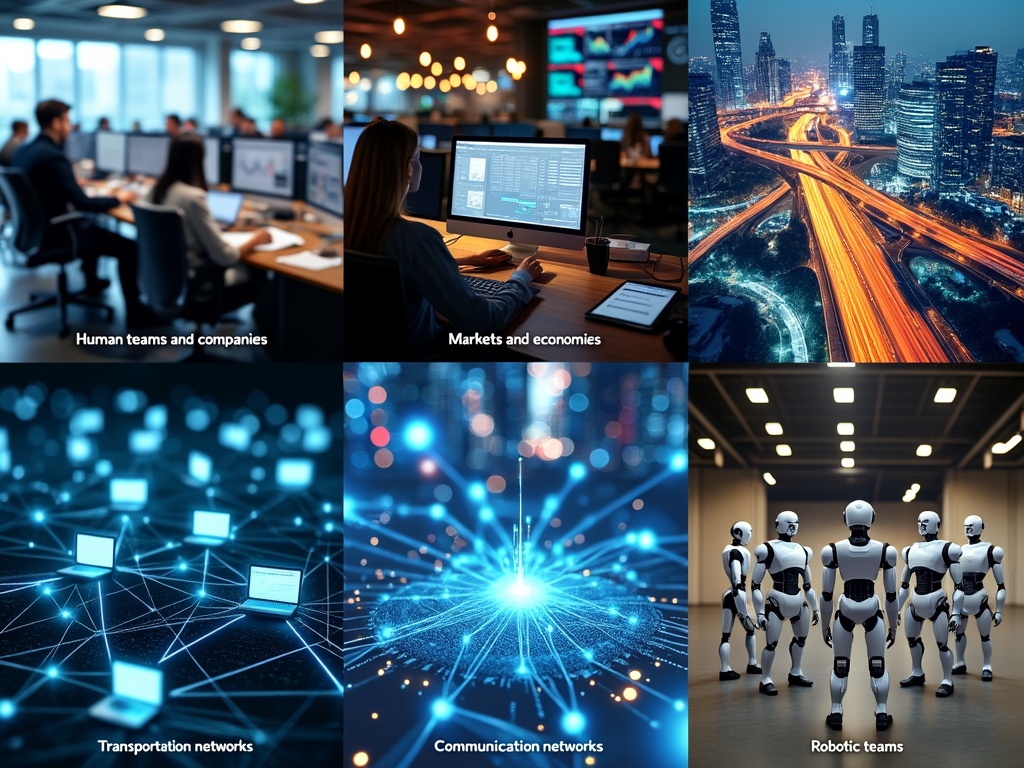Future Trends in Agent Architectures for Distributed AI
A revolution is unfolding in artificial intelligence as autonomous agents evolve from simple chatbots into sophisticated digital workers capable of reasoning, planning, and executing complex tasks with minimal human oversight. According to recent industry analysis, by 2028 these AI agents may operate in vast interconnected networks, fundamentally transforming how businesses function and automate processes.
Picture a future where billions of AI agents collaborate seamlessly, handling everything from customer service to manufacturing operations. Already, major tech companies are racing to develop frameworks that enable these agents to understand context, maintain long-term memory, and make nuanced decisions. The implications are both thrilling and sobering – while autonomous agents promise unprecedented efficiency and automation, they also raise critical questions about security, ethics, and human oversight.
Consider this: 96% of executives surveyed believe AI agent ecosystems will present significant opportunities for their organizations in the next three years. This isn’t just another tech trend – it’s a fundamental shift in how we approach automation and artificial intelligence. The architecture of these systems is evolving rapidly, moving beyond simple rule-based operations to incorporate sophisticated capabilities like dynamic learning, predictive analytics, and human-like reasoning.
However, the path forward isn’t without its challenges. Current autonomous agents still struggle with deep contextual understanding, face significant integration hurdles with existing systems, and require robust security measures to prevent misuse. As these technologies mature, finding the right balance between autonomy and control will be crucial for organizations looking to harness their potential.
The next wave of agent architectures promises to bridge these gaps, introducing innovations in areas like multi-agent collaboration, ethical decision-making frameworks, and seamless integration with human workflows.
Technological Underpinnings of AI Agents
Modern AI agents are powered by a synergy between large language models (LLMs) and specialized tools, enabling them to understand, reason, and act autonomously in complex environments. These technological foundations have transformed AI from simple text processors into dynamic problem-solvers capable of handling real-world tasks.
Large language models serve as the cognitive engine of AI agents, processing and generating human-like text based on vast amounts of training data. Unlike traditional programs that follow rigid rules, LLMs can understand nuanced instructions and generate contextually appropriate responses. This capability allows AI agents to engage in natural conversations while planning and executing complex tasks.
Function calling represents a crucial breakthrough in extending the capabilities of AI agents. Through this mechanism, LLMs can interact with external tools and APIs, bridging the gap between language understanding and real-world actions. For example, when an AI agent needs to check the weather, it can automatically generate the appropriate API call to a weather service, process the response, and communicate the results in natural language.
The integration of tool use marks another significant advancement in AI agent architecture. Tools serve as a middleware layer between the LLM and its environment, allowing the agent to perform specific actions like searching databases, executing calculations, or controlling external systems. This capability enables AI agents to handle tasks that would be impossible through language processing alone.
A key innovation in tool use is the agent’s ability to reason about which tools to employ and when to use them. Through techniques like chain-of-thought prompting and reactive planning, AI agents can break down complex tasks into manageable steps and select the appropriate tools for each stage. This sophisticated decision-making process mirrors human problem-solving strategies.
The effectiveness of these technological components relies heavily on their seamless integration. When an AI agent receives a task, it simultaneously leverages its language understanding to comprehend the goal, its reasoning capabilities to develop a plan, and its tool-use abilities to execute the necessary actions. This coordinated approach enables the agent to handle increasingly complex challenges while maintaining reliability and accuracy.
Role of Multi-Agent Systems


Multi-agent systems represent an innovative approach to problem-solving, where multiple AI agents work together like a well-coordinated team of specialists. Each agent, equipped with unique capabilities and expertise, contributes to tackling complex challenges that would overwhelm a single agent working alone.
The power of these systems lies in their ability to divide and conquer. Much like how a successful company assigns different roles to employees with specialized skills, multi-agent systems distribute complex tasks across specialized agents, allowing each to focus on what it does best. Imagine a group of agents working on content creation—one might excel at research, another at writing, and a third at fact-checking, all collaborating seamlessly to produce high-quality output.
Specialization within these systems creates remarkable efficiency gains. When agents focus on specific tasks, they develop deeper expertise and can handle intricate challenges with greater precision. For instance, in a financial trading system, different agents might specialize in market analysis, risk assessment, and trade execution, working in concert to make more informed decisions.
The modular nature of multi-agent systems offers unprecedented flexibility and scalability. Like building blocks that can be rearranged and expanded, these systems can easily adapt to new challenges by adding, removing, or reconfiguring agents. This adaptability proves invaluable in dynamic environments where requirements frequently change.
The beauty of collaborative learning lies in its ability to generate creative solutions that might elude a more homogeneous system. As agents converse and build on each other’s ideas, they can explore a wider range of possibilities and uncover approaches that individual agents might overlook.
Chi Wang, Principal Researcher at Microsoft
Perhaps most importantly, multi-agent systems demonstrate remarkable resilience. Unlike single-agent solutions where a failure can bring the entire system down, multi-agent systems can continue operating even if individual agents encounter problems.
This distributed approach ensures greater reliability and continuous operation, much like how a team can adapt when one member is temporarily unavailable.
Application Areas for AI Agents


Humanoid robots working on laptops in a modern office.
AI agents are transforming how organizations operate across multiple domains. From streamlining customer interactions to enhancing regulatory compliance, these intelligent systems are improving traditional business processes with remarkable precision and efficiency.
AI Agents in Customer Support
In customer service, AI agents are reshaping business interactions. Maven AGI, for instance, has achieved a 93% efficiency rate in handling customer inquiries without human intervention, showcasing the capabilities of modern AI support systems. These agents manage multiple interactions simultaneously, provide instant responses to common queries, and escalate complex issues to human agents when necessary. They understand context, emotion, and intent in customer communications.
These systems learn from each interaction, improving their response accuracy and customer service capabilities. They analyze customer sentiment in real-time, adjusting their communication style to better serve individual needs. AI agents also excel at proactive service, identifying potential issues before they escalate and reaching out to customers with relevant information or assistance, significantly improving customer satisfaction while reducing support ticket volumes.
| AI Agent | Efficiency Rate | Additional Notes |
|---|---|---|
| Maven AGI | 93% | Handles inquiries without human intervention |
| Lyro by Tidio | 70% | Automates customer requests |
| General AI Chatbots | Up to 70% | Preferred by 62% of customers for speed |
| AI Support Software | 20% increase in satisfaction | Positive customer experiences |
Integrating these agents into customer service frameworks has reduced response times from hours to seconds while maintaining consistent service quality across all touchpoints.
AI Agents in Regulatory Compliance
AI agents have transformed regulatory compliance from a manual process into a streamlined operation. Compliance expert John Nay at Norm AI highlights that these agents can fully automate complex compliance tasks. They continuously monitor transactions, communications, and operations for potential violations, providing real-time alerts when issues are detected. AI agents process vast amounts of regulatory data across multiple jurisdictions simultaneously.
Financial institutions use AI agents to achieve compliance rates exceeding 90% accuracy in routine operations, with even higher precision (99%) for critical financial transactions. This reduces the risk of costly compliance violations and ensures consistent adherence to regulatory requirements. These agents can quickly integrate new regulations into their monitoring systems, keeping organizations compliant with the latest requirements without manual intervention. They also generate detailed audit trails and compliance reports, providing comprehensive documentation of regulatory adherence crucial during audits.
AI Agents in Data Science
AI agents in data science autonomously perform complex analytical tasks, excelling at pattern recognition, predictive modeling, and automated feature engineering. They significantly accelerate the data analysis process. Modern AI agents manage the entire analytics pipeline, from data cleaning and preprocessing to model development and deployment. They identify anomalies, trends, and correlations that might be missed by human analysts, providing deeper insights from complex datasets.
Tasks that once took data scientists weeks can now be completed in hours or minutes with AI assistance, allowing organizations to make data-driven decisions more quickly. These agents maintain data quality by automatically detecting and correcting inconsistencies and ensuring analyses meet rigorous statistical standards. They generate detailed documentation of their analytical processes, making results more transparent and reproducible.
AI agents in data science continuously monitor and update their models, ensuring analyses remain accurate and relevant as new data becomes available. This adaptive capability is crucial for maintaining the reliability of data-driven insights over time.
Integration Challenges and Solutions


Symbolizing cybersecurity and data protection.
The rapid evolution of AI agent technology brings unprecedented opportunities for business transformation, but integrating these sophisticated systems into existing IT infrastructure presents significant technical and organizational hurdles. Organizations must carefully navigate challenges spanning system compatibility, data security, and user acceptance to realize AI’s full potential.
System compatibility emerges as a primary obstacle when merging AI agents with legacy infrastructure. Many existing systems were not designed to interface with modern AI technologies, leading to data format mismatches and communication barriers. As highlighted in recent industry research, organizations often struggle with outdated architectures that lack standardized APIs and integration points needed for seamless AI deployment.
Data Security Imperatives
Data security stands out as a critical concern when implementing AI agents. These systems require access to vast amounts of organizational data to function effectively, creating new attack surfaces and privacy risks. The challenge intensifies as AI agents often need to process sensitive information across multiple systems and databases.
To address these security challenges, organizations must implement robust encryption protocols and access controls specifically designed for AI deployments. This includes securing data both at rest and in transit, while ensuring AI agents can still efficiently process the information they need.
Modern enterprise environments demand a comprehensive security approach that includes:
- End-to-end encryption for all AI agent communications
- Granular access controls and authentication mechanisms
- Regular security audits and vulnerability assessments
- Secure data tokenization and masking techniques
User Acceptance and Change Management
Perhaps the most nuanced challenge lies in fostering user acceptance of AI agents. Many employees express concerns about job displacement or resist adapting their workflows to accommodate new AI-driven processes. Successfully integrating AI agents requires a thoughtful change management strategy that addresses these human factors.
The success of AI integration ultimately depends on building trust and demonstrating clear value to end-users. Technical excellence alone is not enough – the human element must be carefully considered and managed.
Gartner Research
Organizations can improve user acceptance by implementing targeted training programs, clearly communicating the benefits of AI adoption, and involving key stakeholders early in the integration process. Starting with pilot programs in receptive departments can help build momentum and demonstrate success stories.
Solutions and Best Practices
To overcome these integration challenges, organizations should adopt a systematic approach that addresses technical, security, and human factors in parallel. This includes establishing clear data governance frameworks, implementing robust security controls, and developing comprehensive change management strategies.
Key solutions include deploying API gateways to handle compatibility issues, utilizing secure middleware layers for data translation, and implementing role-based access controls. Organizations should also consider cloud-native architectures that can more easily accommodate AI agent integration while maintaining security and scalability.
Success in AI integration requires ongoing commitment to monitoring, optimization, and user support. Regular assessments help identify potential issues early, while continuous feedback loops ensure the system evolves to meet changing organizational needs.
| Challenge | Solution |
|---|---|
| System Compatibility | Deploy API gateways, utilize secure middleware layers, and consider cloud-native architectures. |
| Data Security | Implement robust encryption protocols, granular access controls, regular security audits, and secure data tokenization. |
| User Acceptance | Implement targeted training programs, communicate benefits clearly, involve stakeholders early, and start with pilot programs. |
SmythOS and Its Advantages
SmythOS transforms AI agent development through its comprehensive platform that combines power with unprecedented ease of use. The system’s intuitive drag-and-drop interface enables both developers and non-technical users to build sophisticated AI workflows without extensive coding knowledge.
A standout advantage of SmythOS lies in its robust built-in monitoring capabilities. The platform provides comprehensive logs and real-time visibility into agent activities, allowing organizations to track performance, identify issues, and optimize operations efficiently. This level of oversight ensures AI agents operate reliably and maintain peak performance.
Enterprise-grade security stands as another cornerstone of SmythOS’s offering. The platform implements military-grade encryption protocols to protect sensitive data both at rest and in transit. Additionally, advanced features like OAuth integration and IP control provide granular access management, making it an ideal choice for organizations handling sensitive information.
Enterprise users particularly appreciate SmythOS’s seamless API integration capabilities, which enable connection with over 300,000 different tools and services. This extensive integration ecosystem allows businesses to connect their AI agents with existing workflows and systems without friction.
The platform’s innovative Agent Work Scheduler enables automated, timed execution of agent tasks. This feature eliminates the need for constant human oversight, allowing organizations to deploy truly autonomous AI solutions that operate on schedule or trigger based on specific events.
SmythOS further distinguishes itself through its flexible deployment options. Whether organizations need to implement AI as chatbots, backend APIs, or specialized tools, the platform accommodates various deployment scenarios while maintaining consistent performance and security standards.
SmythOS transforms this process, enabling AI agent development in just 2-4 weeks with 90% faster deployment, visual debugging, and reusable components.
Alexander De Ridder, CTO at SmythOS
The platform’s scalability ensures that as organizations grow, their AI infrastructure can evolve seamlessly. SmythOS handles resource management and scaling automatically, removing the technical burden from teams and allowing them to focus on innovation rather than infrastructure maintenance.
Enterprise security controls add another layer of protection, with features like constrained alignment ensuring AI agents operate within defined parameters. This combination of security and control makes SmythOS particularly valuable for organizations in regulated industries or those handling sensitive data.
Perhaps most significantly, SmythOS democratizes access to sophisticated AI capabilities. Its visual workflow builder and extensive template library enable rapid development and deployment of AI solutions, dramatically reducing the time and resources typically required for such implementations.
Future Prospective and Directions
AI agent architectures are evolving, marking a significant juncture in innovation and practical application. The landscape of autonomous agents is transforming rapidly, driven by emerging frameworks that push the boundaries of artificial intelligence. Recent research from a comprehensive survey on AI agent architectures highlights notable advancements in reasoning capabilities, planning mechanisms, and tool integration.
Looking ahead, multi-agent systems will likely become more sophisticated, enabling complex collaborative problem-solving. These systems are expected to incorporate advanced reinforcement learning techniques, allowing agents to learn and adapt from real-time experiences. Natural language processing capabilities will further enhance human-agent interactions, making these systems more intuitive and accessible.
A promising direction is the development of robust ethical frameworks for AI agents. As these systems gain autonomy, ensuring they operate within clear ethical boundaries and maintain transparency in decision-making processes is crucial. This includes advancing explainable AI techniques that help users understand and trust the reasoning behind agent actions.
AI agents are evolving from simple task executors to sophisticated collaborative systems that can reason, plan, and adapt to complex environments.
Dr. Eric Topol, Digital Medicine Researcher
The future of AI agent architectures will likely see enhanced integration with Internet of Things (IoT) devices, enabling agents to interact more effectively with the physical world. This convergence will create opportunities for agents to process vast amounts of sensor data in real-time, making swift, informed decisions across various domains from smart cities to industrial automation.
As these technologies advance, platforms like SmythOS are positioned to play a crucial role in democratizing access to AI agent development. With its visual debugging environment and support for multiple agent coordination, SmythOS provides the infrastructure needed to build and deploy increasingly complex autonomous systems. The platform’s emphasis on scalability and security will become even more valuable as AI agents take on more critical roles in business operations.
Last updated:
Disclaimer: The information presented in this article is for general informational purposes only and is provided as is. While we strive to keep the content up-to-date and accurate, we make no representations or warranties of any kind, express or implied, about the completeness, accuracy, reliability, suitability, or availability of the information contained in this article.
Any reliance you place on such information is strictly at your own risk. We reserve the right to make additions, deletions, or modifications to the contents of this article at any time without prior notice.
In no event will we be liable for any loss or damage including without limitation, indirect or consequential loss or damage, or any loss or damage whatsoever arising from loss of data, profits, or any other loss not specified herein arising out of, or in connection with, the use of this article.
Despite our best efforts, this article may contain oversights, errors, or omissions. If you notice any inaccuracies or have concerns about the content, please report them through our content feedback form. Your input helps us maintain the quality and reliability of our information.
